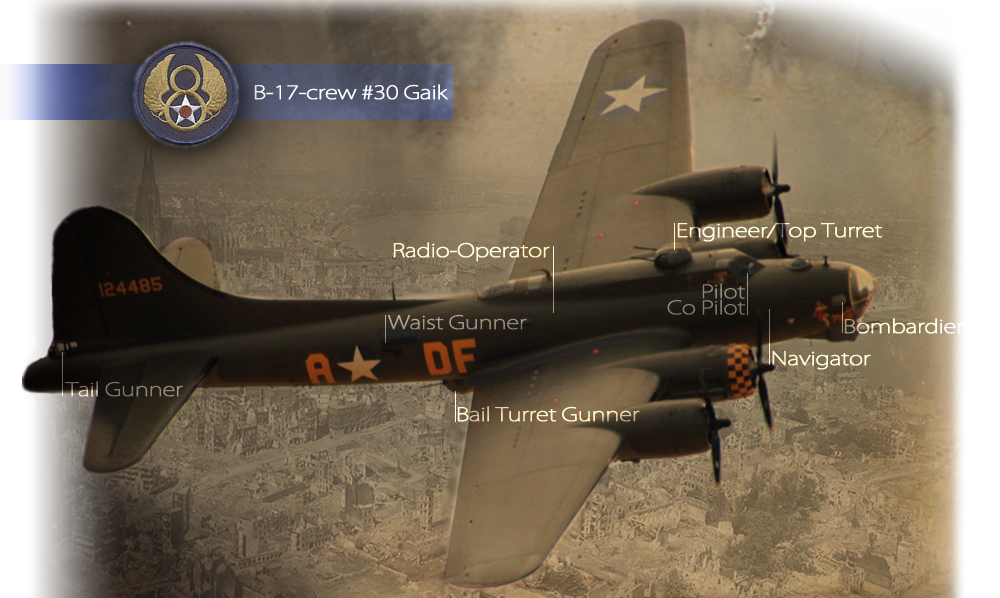[:us]
Co-Pilot:
The Fortress, like other American medium and heavy bombers, was designed to carry two pilots, a requirement of all multi-engined US Army aircraft. Other airforces considered this a waste of skilled manpower but the policy was thoroughly proven by the Americans in combat. The rigors of close formation flying for long periods of time would place tremendous physical and mental strain on a single pilot. For that reason alone the co-pilot or “guy in the right seat” was essential. There were many occasions when one pilot became a battle casualty and the presence of the second pilot saved the crew as well as the aircraft.
Prior to the start of a mission, after a ground inspection of the airplane, the crew would wait for the signal from the tower to start the engines. Once the signal was received the co-pilot would read the prestart check. Upon completion of the checklist the co-pilot would prime and start each engine. The engines would be warmed up at 1000 rpm. Prop feathering was checked at 1500 rpm. Each engine was then run up to test magnetos and turbos.
As the B-17’s started moving into position the crew would be watching for the tail number of the aircraft they would follow for take-off. Once their assigned plane was spotted the co-pilot would release the parking brake and roll on to the taxiway. The tail wheel lock situated on the cockpit floor was operated by the co-pilot and would have to be unlocked and locked often during taxiing, particularly on curved perimeter taxiways. When their time came for take off, the pilot would line up the plane and the co-pilot would lock the tail wheel. At this critical stage, the co-pilot had to keep his eyes on the instruments, as the pilot advanced the throttles. The co-pilot followed through with the throttle controls, taking them over from the pilot as soon as maximum power was reached. Normally, with a full bomb load, every bit of runway was used.
After takeoff, the pilot would call for gear up and as the co-pilot actuated the landing gear switch, he would also apply the brakes to stop the wheels from spinning. Once assembled in the formation, the co-pilot normally flew the plane as much as the pilot. The pilot in command had to have his eyes glued to his lead aircraft, even during fighter attacks and flak. The pilot that wasn’t flying monitored the instruments and intercom.
After the bombing run on the return leg from the mission and when out of danger, the formation could loosen up. In the landing pattern, the co-pilot lowered the gear and flaps for touch down. Upon reaching the dispersal point the co-pilot would verify that all switches were off before leaving the aircraft.
| Carroll,James D
1st LT |
Co-Pilot | All 21 missions with crew # 30 Gaik | WIA 31-12-1944
KIA 14-02-1945 |
[:nl]
Co-Pilot:
“The Fortress”, net zoals andere Amerikaanse Medium en Heavy Bommenwerpers, was ontworpen om gevlogen te worden door 2 piloten, een voorwaarde voor alle US Army vliegtuigen met meerdere motoren. Andere luchtmachten vonden dit een verspilling van goede mankrachten, maar in de praktijk bewezen de Amerikanen het recht van deze maatregel. De ontberingen van vliegen in enge formaties gedurende lange tijd legden een enorme fysieke en psychische druk en stress op een enkele piloot. Alleen al om deze reden was de co-piloot of te wel “de man in de rechter stoel” essentieel. Er deden zich vele gelegenheden voor waarbij een van de piloten gewond of gedood werd en het feit dat er een 2e piloot aanwezig was de redding bleek voor zowel de crew als het vliegtuig.
Voor aanvang van een missie, na een grond-check van het vliegtuig, moest de crew wachten met het starten van de motoren op toestemming van de controletoren. Als het signaal ontvangen werd las de co-piloot de checklijst voor. Na het doorlopen en goedbevinden van de checklijst moest de co-piloot de motoren een voor een starten. De motoren werden opgewarmd op 1000 toeren per minuut en op diverse punten getest.
Als de B-17’s zich in positie manoevreerden moest de bemanning letten op het staartnummer van het toestel dat voor hen moest opstijgen. Zodra ze dit toestel gespot hadden haalde de co-piloot de parkeerrem van het toestel af en rolden ze naar de taxibaan. De staartwielrem, op de vloer van de cockpit, moest regelmatig tijdens het taxiën bediend worden door de co-piloot zeker op bochtige taxibanen. Als ze zover waren om op te stijgen plaatste de piloot het toestel in de juiste positie en blokkeerde de co-piloot het staartwiel. Vanaf dit kritieke moment moest de co-piloot zijn ogen richten op alle instrumenten terwijl de piloot de gashendels bediende. De co-piloot assisteerde daarna bij full power met de gashendels. Normaal gesproken werd elke meter van de startbaan gebruikt bij volle belading van het vliegtuig met bommen.
Na de take-off vroeg de piloot om te versnellen, de co-piloot zou het landingsgestel inklappen en daarbij de remmen op de wielen plaatsen voor de stabiliteit. Eenmaal in formatie/positie zou de co-piloot net zo vaak het toestel besturen als de piloot. De piloot moest zijn ogen gericht houden naar zijn voorganger in de formatie, zelfs tijdens een luchtgevecht met de vijand en luchtafweer. De piloot die niet stuurde had als taak de instrumenten en de intercom in de gaten te houden.
Na de landing zorgde de co-piloot er voor dat alle schakelaars en instrumenten uitgeschakeld waren voordat ze het toestel zouden verlaten.
| Carroll, James D
1st LT |
Co-Pilot |
|
WIA 31-12-1944
KIA 14-02-1945 |

